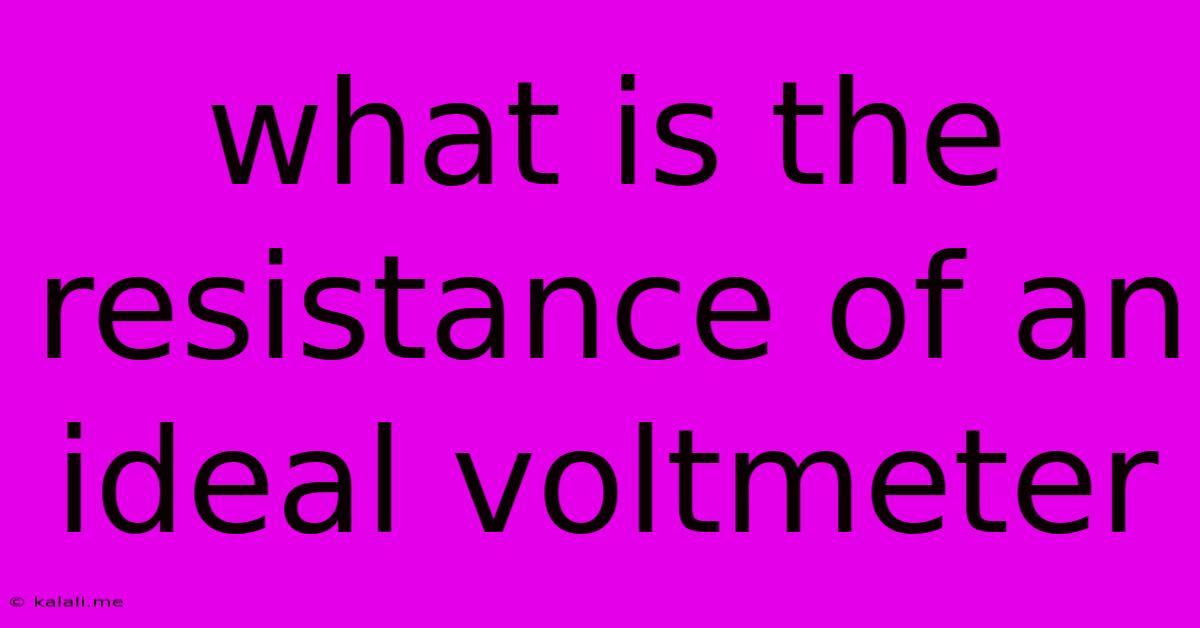What Is The Resistance Of An Ideal Voltmeter
Kalali
Jun 14, 2025 · 3 min read

Table of Contents
What is the Resistance of an Ideal Voltmeter?
The resistance of an ideal voltmeter is infinite. This is a crucial concept in electrical measurements and understanding circuit behavior. Let's delve deeper into why this is the case and what implications it has. This article will explore the characteristics of ideal voltmeters, the practical limitations of real-world voltmeters, and the importance of high input impedance in accurate voltage measurements.
Understanding the Role of a Voltmeter
A voltmeter is an instrument used to measure the potential difference, or voltage, between two points in an electrical circuit. To do this accurately, it must draw as little current as possible from the circuit being measured. If the voltmeter draws significant current, it will alter the circuit's behavior, leading to inaccurate readings. This is where the concept of an ideal voltmeter's infinite resistance comes into play.
Why Infinite Resistance is Ideal
An ideal voltmeter has infinite resistance because it's designed to measure voltage without affecting the circuit under test. A voltmeter with infinite resistance means no current flows through it. Consequently, there's no voltage drop across the voltmeter itself, ensuring the measured voltage is the true voltage across the circuit element being measured. This preserves the integrity of the circuit and guarantees accurate readings.
The Practical Limitations of Real Voltmeters
While an ideal voltmeter possesses infinite resistance, real-world voltmeters have extremely high, but finite, resistance. This resistance is typically measured in megaohms (MΩ) or even gigaohms (GΩ). The higher the resistance, the closer the real voltmeter's behavior approaches that of an ideal voltmeter.
The current drawn by a real voltmeter is usually negligible compared to the circuit currents, making the measurement error small and often acceptable for most applications. However, in sensitive circuits with high impedance or low current levels, even the small current drawn by a real voltmeter can significantly affect the circuit's operation and lead to inaccurate voltage readings. This is especially true when dealing with high-impedance circuits like those found in certain types of sensors or op-amp circuits.
The Importance of High Input Impedance
The high input impedance of a voltmeter is a critical factor in ensuring accurate measurements. Input impedance refers to the resistance presented by the voltmeter to the circuit. A high input impedance minimizes the current drawn from the circuit, thus reducing the loading effect and ensuring accurate readings. The closer the input impedance is to infinity, the more accurate the voltage measurement will be.
Choosing the Right Voltmeter
When selecting a voltmeter for a specific application, it's crucial to consider the input impedance. For circuits with high impedance or low current levels, a voltmeter with a very high input impedance is essential to minimize the loading effect and obtain accurate readings. This necessitates careful selection based on the specific characteristics of the circuit being measured and the required level of accuracy.
In summary, although a voltmeter with truly infinite resistance is an idealized concept, the closer a real voltmeter’s resistance approaches infinity, the more accurate and reliable the voltage measurements will be. Understanding the concept of an ideal voltmeter's infinite resistance and the importance of high input impedance is fundamental for accurate electrical measurements and circuit analysis.
Latest Posts
Latest Posts
-
Least Common Multiple Of 32 And 40
Jun 15, 2025
-
What Are Factor Pairs Of 32
Jun 15, 2025
-
How To Make 35 In Roman Numerals
Jun 15, 2025
-
Difference Between Perfect Competition And Monopolistic Competition
Jun 15, 2025
-
At What Temperature In Fahrenheit Does Water Freeze
Jun 15, 2025
Related Post
Thank you for visiting our website which covers about What Is The Resistance Of An Ideal Voltmeter . We hope the information provided has been useful to you. Feel free to contact us if you have any questions or need further assistance. See you next time and don't miss to bookmark.